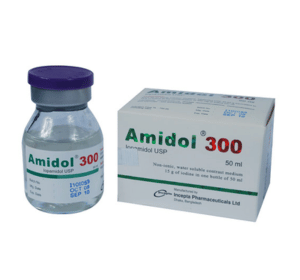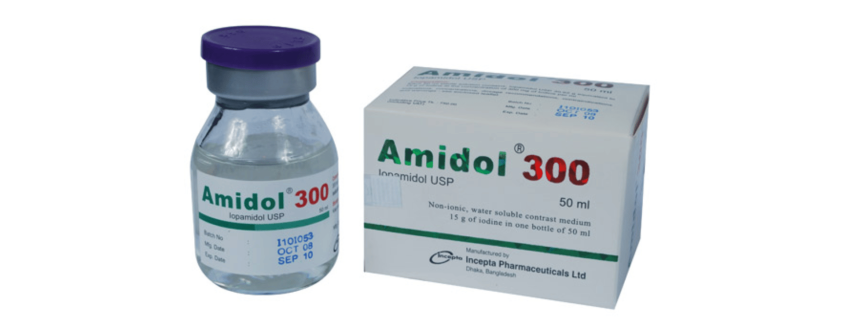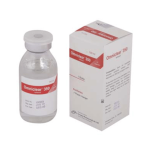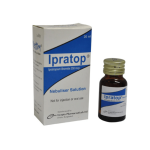Amidol(Iopamidol)

Therapeutic Group: Iodinated Contrast agent
Presentation
Amidol is presented as a clear colorless sterile injectable solution in the following concentrations :
Amidol 300, 50 ml sterile solution contains 30.62 g of Iopamidol equivalent to 300 mg of Iodine per ml.
Amidol 370, 50 ml sterile solution contains 37.76 g of Iopamidol equivalent to 370 mg of Iodine per ml.
Amidol 370, 100 ml sterile solution contains 75.53 g of Iopamidol equivalent to 370 mg of Iodine per ml.
Description
Iopamidol, an organic Iodine compound and used as a non-ionic water soluble radiographic contrast medium. Iopamidol blocks X-rays as they pass through the body, thereby allowing body structures not containing Iodine to be visualized. The degree of opacity produced by Iopamidol is directly proportional to the total amount of the iodinated contrast agent in the path of the X-rays. The visualization of body structures is dependent upon the distribution and elimination of Iopamidol.
Indications
NEURORADIOLOGY-Lumber myelography, thoraco-cervical myelography, ANGIOGRAPHY- Cerebral angiography, selective coronary angiography, left ventriculography, aortography, angiocadiography, selective visceral arteriography, peripheral arteriography, digital subtraction angiography, venography, urography, OTHER DIAGNOSTIC PROCEDURES-Contrast enhancement in CT scanning, arthrography, fistulography.
Dosage & Administration
Adult dosage
NEURORADIOLOGY
Lumber myelography: Amidol 300, 5-10 ml; Amidol 370, 6-13 ml
Thoraco-cervical myelography: Amidol 300, 5-10 ml; Amidol 370, 6-13 ml
ANGIOGRAPHY
Cerebral angiography: Amidol 300, 5-10 ml; Amidol 370, 6-13 ml
Selective coronary arteriography: Amidol 300/370, 4-8 ml/artery
Peripheral arteriography: Amidol 300/370, 20-50 ml
Venography: Amidol 300, 20-50 ml; Amidol 370, 24-60 ml
Angiocardiography: Amidol 300/370, 30-80 ml
Left ventriculography: Amidol 300/370, 30-80 ml
Percutaneous transfemoral / renal arteriography: Amidol 300/370, 30 ml
Selective renal arteriography: Amidol 300/370, 5-10 ml
Selective visceral arteriography: Hepatic angiography: Amidol 300, 30 ml; Amidol 370, 70 ml
Coeliac angiography: Amidol 300/370, 40-70 ml
Superior mesenteric angiography: Amidol 300/370, 25-50 ml
Inferior mesenteric angiography: Amidol 300/370, 5-30 ml
Digital subtraction angiography: 30-50ml (10-20 ml/sec ) of Amidol 300/370,i.v 25 ml (left ventricle), 2-5 ml (coronary arteries) ,15 ml/sec. of Amidol 300/370 i.a for cardiac imaging
UROGRAPHY
Amidol 300/370, 40-80 ml i.v up to 1.5 ml/kg in severe renal disease.
OTHER DIAGNOSTIC PROCEDURES
Contrast enhancement in CT scanning: Amidol 300/370, 0.5-2.0 ml /kg
Arthrography: Amidol 300, 1-10 ml
Children: 1-2.5 ml/kg.
Method of administration
NEURORADIOLOGY
Lumber myelography: A slow sub-arachnoid injection is made through a fine lumber puncture needle into one of the lower interspinous spaces (L3-L4 or L4-L5). Optimum contrast appears immediately after injections and films should be obtained promptly.
Thoraco-cervical myelography: Following a slow sub-arachnoid injection the patient should be turned on his/her side and tilted 10o-20o head down under fluoroscopic control. In this manner it is possible to control movement of the contrast medium column into the dorsal region.
If the cervical region is to be examined, the contrast medium should be run into the cervical region first, before the examination of the dorsal areas where it is progressively diluted. Amidol 300/370 may also be injected sub-occipitally or by lateral puncture technique .Care should be taken to ensure that the contrast medium does not move intracranially. It is generally recommended that in intrathecal use the patient should remain with a raised bed head and be kept well hydrated; following hydration it is preferable that the patient be allowed to be ambulatory .
ANGIOGRAPHY
Cerebral angiography: Any current technique is suitable for radiological visualization of the cerebral vasculature with Amidol 370/300 injection. Carotid and vertebral angiography, performed by catheterization or percutaneous injection techniques, require rapid injection which, if necessary, may be repeated.
Peripheral arteriography and venography: Percutaneous injection into the appropriate blood vessel is used for visualization of peripheral arteries and veins.
Angiocardiography, left ventriculography, selective coronary arteriography: Amidol 370/300 injection may be administered by rapid injection through a catheter into a suitable peripheral artery or vein. It can also be introduced under pressure through a cardiac catheter in to any of the heart chambers, or injected into large vessel for immediate visualization. The contrast medium may also be administered during selective catheterization of the coronary arteries.
Aortography: The contrast medium may be introduced directly or by intra-arterial injection for visualization of the aorta and its main branches.
Selective visceral angiography: Visualization can be achieved by selective catheterization and injection into the hepatic, coeliac or mesenteric arteries.
Digital subtraction angiography: For cardiac imaging the contrast medium may be administered intra-arterially by selective catheterization to provide substrated images. Amidol 370/300 injected intravenously either centrally or peripherally is also recommended for use this modality.
UROGRAPHY
The contrast medium injected intravenously and rapidly eliminated through the kidneys. In patients with severe renal failure, high dose urography should be used.
OTHER DIAGNOSTIC PROCEDURES
Arthrography: Visualization of joint cavities and articular surfaces can be achieved either single or double contrast examination.
Contrast enhancement in CT scanning: Contrast enhancement for brain scans can be achieved between one and three minutes after i.v. injection
Amidol 370/300 are also be used for total body scanning examinations after i.v.administration as a bolus, as a drip infusion or by combination of the two methods.
Side Effects
The use of organic Iodine compounds may cause untoward side effects and manifestations of anaphylaxis. The symptoms include nausea, vomiting, widespread erythema, generalized heat sensation, headache, coryza, fever, sweating, asthenia, dizziness, pallor, dyspnea, and moderate hypotension. Skin reactions occur in the form of various types of rash or diffuse blister formation. More severe reactions involving the cardiovascular system such as peripheral vasodilation with pronounced hypotension, tachycardia, dyspnea, agitation, cyanosis and loss of consciousness, may require emergency treatment. During intracardiac and /or coronary arteriography, ventricular arrhythmia may infrequently occur. Hyperthyroidism may recur in patients previously treated for graves disease.
Precautions
GENERAL: Amidol 370/300 should not be drawn into the syringe until immediately before use. The bottle, once opened, must be used immediately. In consideration of possible serious side effect the use of organoiodinate contrast media should be limited to cases for which there is a precise need for radiographic contrast examination. This should be evaluated according to clinical status of the patient, in particular in relation to pathologies of the cardiovascular, urinary or hepatobiliary system. In particular contrast media designed for cardioangiography should be used in hospitals or clinics equipped and staffed for intensive care in emergencies. For other diagnostic procedures requiring the use of iodinised contrast media, in the public or institutions where such procedures take place, resuscitation equipment and therapeutic measures should be immediately available .When examining small children or babies, do not limit fluid intake before administering a hypertonic contrast solution. Also correct any existing water and electrolyte imbalance. X-ray examination of woman should also, if possible be conducted during the pre-ovulation phage of menstrual cycle. In patients scheduled for thyroid examination with a radioactive Iodine tracer, one must take into consideration that Iodine uptake in the thyroid gland will be reduced for several days (up to two weeks) after dosing with an iodinised contrast medium that is eliminated through kidney. Biguanide oral anti diabetic agents e.g. Metformin, are excreted unchanged through the kidneys. They therefore compete for excretion in the kidneys with contrast media and this could lead to reduction in kidney function. Patient with NIDDM who are taking Metformin or other biguanides should therefore be instructed not to take any doses of Metformin for 48 hours before and 48 hours after the X-ray examination.
NEURORADIOLOGY
In the event of CSF blockade, remove as much of the administrated contrast solution as possible. The use of organic Iodine contrast media may be contraindicated for patients with a history of epilepsy. Also the presence of blood in the CSF contraindicates the use of Amidol: in such cases, physician should carefully assess the need for the diagnostic procedure against possible risk to the patient. Patients receiving treatment with anticonvulsant drugs must continue such treatment before and after the procedure. Should a convulsive seizure develop during the examination, administer diazepam or sodium Phenobarbital intravenously. Neuroleptics must be absolutely avoided because they lower the seizure threshold .The same applies to analgesics, antiemetics, antihistamines and sedatives of the phenothiazine group. Whenever possible, treatment with such drug should be discontinued at least 48 hours before administration of the contrast medium and not to be resumed less than 12 hours after completion of the procedure.
ANGIOGRAPHY
The use of Amidol as a contrast medium for cerebral angiography, may cause side effects, which are usually mild and short duration. Many patient report a sensation of heat in the face and neck; a few complain of headache. A fairly frequent cardiovascular reaction to dosing with Amidol is bradycardia associated with systemic hypotension. The reaction is transient and requires no treatment. Severe neurological sequelae may arise as direct complications of pre-existing pathology in the individual patient. Such reactions are diverse and may include tonic/clonic convulsions, aphasia fainting, hemiparesis and coma. The risk associated with a particular investigation involved may be increased by conditions such as advanced arteriosclerosis, hypertension, heart failure, major systemic disease and recent cerebral embolism or thrombosis. In patients undergoing angiocardiographic procedures special attention should be paid to the status of the right and pulmonary circulation. Right heart insufficiency and pulmonary hypertension may precipitate bradycardia and systemic hypotension when the organic iodine solution is injected. In paediatric roentgenology, one should proceed with great caution when injecting the contrast medium in to the right heart chambers of cyanotic neonates with pulmonary hypertension and impaired cardiac function. In examination of aortic arch the tip of the catheter should be positioned carefully to avoid hypotension, bradycardia, and CNS injury due to the excess pressure transmitted from the injector pump to the brachiocephalic branches of the aorta. Likewise, in abdominal aortography, excess pressure from the pump may cause renal infarction, spinal cord injury, retroperitoneal bleeding, intestinal infarction and necrosis.
UROGRAPHY
Care should be exercised in patients with moderate to severe impairment of renal function. Substantial deterioration in renal function is minimised if the patient is well hydrated. Renal function parameters, especially urine out put, should be monitored after the examination in these patients.
Use in pregnancy and lactation: In pregnant woman, Iopamidol injection should be administered only if the procedure is considered essential by the physician. Fertility and mutagenicity studies have shown that Iopamidol has no influence on these parameters. Teratogenicity studies in rats and rabbits have shown no influence of Iopamidol up to 8.2g /kg (rat) and 4.1 g /kg (rabbit)
Use in Pregnancy & Lactation
In pregnant woman, Iopamidol injection should be administered only if the procedure is considered essential by the physician. Fertility and mutagenicity studies have shown that Iopamidol has no influence on these parameters. Teratogenicity studies in rats and rabbits have shown no influence of Iopamidol up to 8.2g /kg (rat) and 4.1 g /kg (rabbit).
Drug Interaction
Thyroid function test-use of Amidol 370/300 may interfere with tests or thyroid function. Biguanide oral anti diabetic agents e.g. Metformin, are excreted unchanged through the kidneys .They therefore compete for excretion in the kidneys with contrast media and this could lead to reduction in kidney function. Patient with NIDDM who are taking Metformin or other biguanides should therefore be instructed not to take any doses of Metformin for 48 hours before or 48 hours after the x-ray examination.
Over Dose
Treatments of an overdose is directed toward the support of all vital functions and prompt institution of symptomatic therapy.
Pharmaceutical precaution:
Keep Iopamidol away from light. Store below 30o C. Exceptionally crystallization of Iopamidol injections can occur. It has been shown that such a phenomenon is caused by a damaged container and therefore the product should not be used in this case. The bottle once opened, must be used immediately. Any residue of contrast medium must be discarded.
Commercial Pack
Amidol 370/300 injection is presented in glass bottle made of type II glass (Ph, Eur.). Bottles are closed with halobutyl stoppers and aluminium crimp top seal-polypropylene caps.
Amidol 300: Each bottle (50 ml) contains: 30.62 g of Iopamidol equivalent to 300 mg of Iodine per ml.
Amidol 370: Each bottle (50 ml) contains: 37.76 g of Iopamidol equivalent to 370 mg of Iodine per ml.
Amidol 370: Each bottle (100 ml) contains: 75.53 g of Iopamidol equivalent to 370 mg of Iodine per ml.



